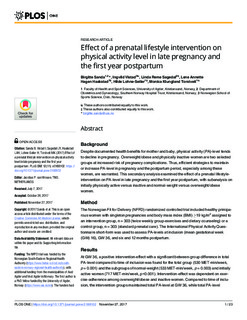| dc.contributor.author | Sanda, Birgitte | |
| dc.contributor.author | Vistad, Ingvild | |
| dc.contributor.author | Sagedal, Linda Reme | |
| dc.contributor.author | Haakstad, Lene Annette Hagen | |
| dc.contributor.author | Lohne-Seiler, Hilde | |
| dc.contributor.author | Torstveit, Monica Klungland | |
| dc.date.accessioned | 2018-05-22T12:16:45Z | |
| dc.date.available | 2018-05-22T12:16:45Z | |
| dc.date.created | 2018-02-02T12:49:03Z | |
| dc.date.issued | 2017 | |
| dc.identifier.citation | PLoS ONE. 2017, 12, e0188102. | nb_NO |
| dc.identifier.issn | 1932-6203 | |
| dc.identifier.uri | http://hdl.handle.net/11250/2498724 | |
| dc.description | This is an open access article distributed under the terms of the Creative Commons Attribution License, which permits unrestricted use, distribution, and reproduction in any medium, provided the original author and source are credited. | nb_NO |
| dc.description.abstract | Background: Despite documented health benefits for mother and baby, physical activity (PA)-level tends to decline in pregnancy. Overweight/obese and physically inactive women are two selected groups at increased risk of pregnancy complications. Thus, efficient strategies to maintain or increase PA-level in pregnancy and the postpartum period, especially among these women, are warranted. This secondary analysis examined the effect of a prenatal lifestyle-intervention on PA-level in late pregnancy and the first year postpartum, with subanalysis on initially physically active versus inactive and normal-weight versus overweight/obese women. Method: The Norwegian Fit for Delivery (NFFD) randomized controlled trial included healthy primiparous women with singleton pregnancies and body mass index (BMI) ≥19 kg/m2 assigned to an intervention group, n = 303 (twice weekly group-exercises and dietary counseling) or a control group, n = 303 (standard prenatal care). The International Physical Activity Questionnaire short-form was used to assess PA-levels at inclusion (mean gestational week (GW) 16), GW 36, and six and 12 months postpartum. Results: At GW 36, a positive intervention-effect with a significant between-group difference in total PA-level compared to time of inclusion was found for the total group (530 MET-min/week, p = 0.001) and the subgroups of normal-weight (533 MET-min/week, p = 0.003) and initially active women (717 MET-min/week, p<0.001). Intervention-effect was dependent on exercise-adherence among overweight/obese and inactive women. Compared to time of inclusion, the intervention groups maintained total PA-level at GW 36, while total PA-level decreased in the control groups. The PA-levels increased postpartum, but with no significant differences between the randomization groups. Conclusion: The NFFD prenatal combined lifestyle intervention had a significant effect on TPA-level in late pregnancy among women entering pregnancy normal-weight or physically active, thereby preventing the downward trend typically seen during pregnancy. Intervention-effect among overweight/obese and physically inactive women was, however, dependent on exercise-adherence. Long-term intervention-effect was not observed in the postpartum period. | nb_NO |
| dc.language.iso | eng | nb_NO |
| dc.subject | physical activity | nb_NO |
| dc.subject | pregnancy | nb_NO |
| dc.subject | exercise | nb_NO |
| dc.subject | walking | nb_NO |
| dc.subject | Norwegian people | nb_NO |
| dc.subject | obesity | nb_NO |
| dc.subject | body mass index | nb_NO |
| dc.subject | gestational diabetes | nb_NO |
| dc.title | Effect of a prenatal lifestyle intervention on physical activity level in late pregnancy and the first year postpartum. | nb_NO |
| dc.type | Journal article | nb_NO |
| dc.type | Peer reviewed | nb_NO |
| dc.description.version | publishedVersion | nb_NO |
| dc.rights.holder | © 2017 Sanda et al. | nb_NO |
| dc.source.journal | PLoS ONE | nb_NO |
| dc.identifier.doi | 10.1371/journal.pone.0188102 | |
| dc.identifier.cristin | 1561286 | |
| dc.description.localcode | Seksjon for idrettsmedisinske fag / Department of Sport Medicine | nb_NO |
| cristin.unitcode | 150,34,0,0 | |
| cristin.unitname | Seksjon for idrettsmedisinske fag | |
| cristin.ispublished | true | |
| cristin.fulltext | original | |
| cristin.qualitycode | 1 | |
